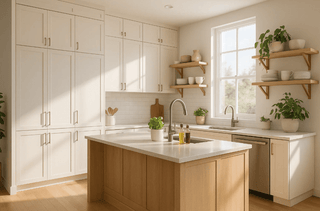There is no kitchen design question that stirs more debate among owners, designers, and contractors than whether kitchen cabinets should reach all the way to the ceiling or not. If you’ve spent hours scrolling through Pinterest or flipping through glossy kitchen magazines, you’ve seen both looks — some kitchens proudly flaunt a seamless wall of cabinetry from floor to ceiling, while others intentionally leave an open gap above the cabinets. Both approaches have strong advocates, and both can create a beautiful, functional kitchen — if done right.
But if that's your plan, the risk does seem greater. Cabinets aren't cheap. You're not just affecting functionality for your kitchen but resale value, maintenance, and general ambiance. Do you go all in and take a chance? Or do you hedge your bets and leave some room in your kitchen?
Let’s explore the pros, cons, and design factors in detail — and by the end, you’ll have a clear sense of which direction is right for your space.
1. The Allure of Ceiling-Height Cabinets
Ceiling-to-wall cabinetry is also becoming increasingly popular these days with open-space living and excess minimalism. There's something about a wall of cabinetry that just goes untouched from countertop to ceiling that just sounds so irretrievably high-end. No dusty smudgy shelf just sitting around in a silly way. No visual break. Just tidy, clean lines.
Maximizing Storage Space
The strongest and most helpful argument for going floor to ceiling with the cabinets is storage. Kitchens are pantry storerooms, especially if they are party pantries or unbalanced kitchens. That top shelf is perfect for out-of-season dinnerware, holiday dinner setting arrangements, or special-use small kitchen gadgets that you only use a few times a year.
Designing a Clean, Uniform Look
Tall cabinetry that just looks great provides you with that high-gloss, fitted look. By eliminating the shadow line and visual clutter that's going to make a kitchen feel smaller or tighter, you're eliminating the space where dust is going to accumulate and rats are going to nest in.
And, of course, there's the functional hygiene factor. That space between average-sized cabinetry and the ceiling? That's where dust, dirt, and, the odd small critters will play. With floor-to-ceiling cabinetry, crumbs or cobwebs have no place to go.
Showcasing with Glass Uppers
Others utilize the top as glass-front display cabinets. They spare in back for displaying antique china, artwork, or deeply colored ceramics. If you are part of a package with RTA kitchen cabinets, you can have this custom look for pennies on the dollar.
2. The Cabinets Flaw That Goes Right to the Ceiling
The more out you go to purchase those floor-to-ceiling units of furniture, you have to make compromises.
Cost Factors
More expensive cabinets require more material, more labor, and likely more complicated installation. Even on a low-end RTA kitchen cabinet, extending to the ceiling will take your cost above standard heights.
Accessibility Issues
Life is that way: aside from the issue of you being rather a bit taller than six feet, you are going to have to step onto a ladder or step stool just in order to reach those upper shelves. Easy enough to store in the long run but perhaps not so easy to use on a semi-regular or regular basis once you have done so.
Space you believe you have but never actually do end up being able to utilize without planning ahead.
Potential for Visual Overload
Too much cabinetry in small kitchens is heavy and bulky as well. Door wall will close off the room, darkening it or tightening it down, respectively, depending on your dark wood tone selection versus light and light-reflected tone such as white cabinets.
Design Challenges
Beams, sloping ceilings, or ductwork ceiling elements can render ceiling-height design challenging. Extending the cabinets higher always appears to be contraflow in a room.
3. Design Considerations Before You Go Tall
It's really a matter of maybe not so much whether you're going to love the look — it's a matter of whether your kitchen, wallet, and life will support it.
Ceiling Height and Proportion
If you have nine-foot or lower ceilings, you should have plenty of room to work with full-height cabinetry. You will more likely have difficulty with double-stacked cabinetry with nine-foot ceilings. That is beautiful but closer to reach and costly.
Kitchen Size
It's perfect for small kitchens but use dark finishes judiciously. White kitchen cabinets or cream whites will be light and airy even if the whole wall is covered in cabinetry.
Your Cooking and Entertaining Style
Do you like everything closed off and out of sight? Ceiling-high cabinets are the solution. Do you like open, airy sensibility? You can do both — tall cabinets in one section, open shelving in other areas.
Maintenance Preferences
And if you detest the inconvenience of needing to get on a ladder in order to dust, ceiling-height cabinetry eliminates the inconvenience of dusting top to bottom on them altogether. Remember, though, you will still need to dust front faces of upper cabinets from time to time.
4. Creative Solutions to Floor-to-Ceiling Cabinets
If you like the appearance but are concerned that it will not be perfect for your situation, don't worry; there are others that you can decide on.
-
Bulkheads or Soffits: Instead of additional cabinetry, top off the wall to ceiling height over your cabinets. You get the clean appearance without storage that you will never use.
-
Open Top Shelves: Narrow band of open shelving along the cabinet's top will create the light visual feel and still permit the room filling.
-
Glass Uppers for Display: Glass-front upper cabinet for storing decorations and picture relief.
-
Two-Tone Cabinetry: Light color, i.e., white cabinets, on upper levels and darker lower levels to ground.
5. Color Problems with Full-Height Cabinets
Your color choice can make or break ceiling-height cabinets' look.
-
White Cabinets: Immaculate, clean, and elegant. Illusion effect to give a feeling of bigger and wider kitchens.
-
Green Cabinets: Bling, but the default option. Stunning in big kitchens where there is a lot of lighting.
-
Brown Cabinets: Warmth and richness, particularly for traditional or country kitchens.
RTA kitchen cabinets allow you to mix and match finishes so that you can have a look that's all your own — white upper cabinets for a light, airy feel, for instance, and a different color on base cabinets to ground the look.
6. Bringing It All Together: A Balanced Approach
Lastly, going to the ceiling with the cabinets is a matter of aesthetics, function, and convenience. The owners compromised — one ceiling height on one wall for maximum storage space and open shelving or standard height on the other so the room is not rendered claustrophobic.
In case you're thinking of taking cabinetry to new heights but haven't yet made your decision — proportion, color, finish — our free design service lets you see your decisions before you buy. We'll guide you through all of your decisions, from space planning to color, so your kitchen looks and feels its best.
7. Final Thought
Floor-to-ceiling storage will create a room without doubt, but not the doorway to a functioning, beautiful kitchen. The solution that is going to function best for your cooking, the look of your home, and your own style is either going to be one that goes up, goes up, goes up or one that gives some elbow room. It is thoughtful of the design — and getting each and every square inch to work a two-way purpose.

























